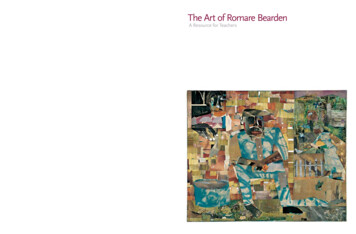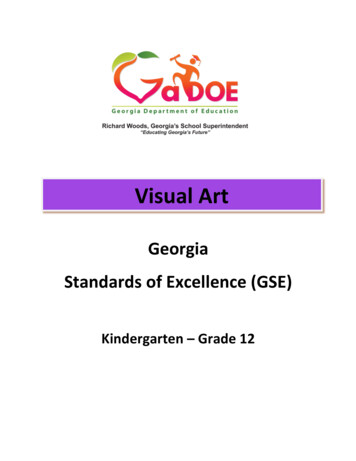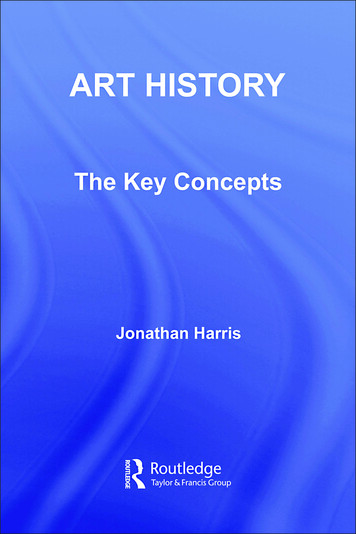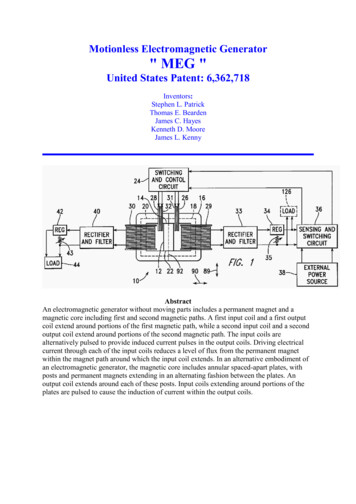
Transcription
Cover 9.9.1 ss11/6/035:52 PMMailing address:2000B South Club DriveLandover, MD 20785The Art of Romare BeardenDivision of EducationNational Gallery of Art, WashingtonPage 1The Art of Romare BeardenA Resource for TeachersA Resource for TeachersNational Gallery of Art, Washington
Cover 9.9.1 ss11/6/035:52 PMPage 2The Art of Romare Bearden is organized by theNational Gallery of Art, Washington.The exhibition is made possible with generous support from AT&T.The exhibition is sponsored in part by Chevy Chase Bank.The exhibition is presented at the following museums:National Gallery of Art, Washington, September 14, 2003 – January 4, 2004San Francisco Museum of Modern Art, February 7 – May 16, 2004Dallas Museum of Art, June 20 – September 12, 2004Whitney Museum of American Art, New York, October 14, 2004 – January 9, 2005High Museum of Art, Atlanta, January 29 – April 24, 2005Written and produced by staff of the National Gallery of Art, Washington.Writers: Carla Brenner, Heidi Hinish, and Barbara Moore, division of education. Photographyresearch, acquisition, and permissions: Ira Bartfield and Sara Sanders-Buell, publicationsdepartment, and Leo Kasun and Lesley Keiner, division of education.Online production: Stephanie Burnett and Rachel Richards, division of education.Thanks for contributions supporting publication of this packet to: Lynn Russell, chair,division of education; Chris Vogel, production manager, publications department;Donna Mann, senior publications manager, education division; Phyllis Hecht, web manager;and staff of the exhibition programs and photography departments. The educationdivision extends special appreciation to Mary Lee Corlett, research associate, andRuth Fine, curator of the exhibition, for their help in realizing this project.Edited by Richard CarterDesigned by Studio A, Alexandria, VirginiaEvery effort has been made to locate copyright holders for the materials used in this book. Anyomissions will be corrected in subsequent printings. 2003 Board of Trustees, National Gallery of Art, WashingtonCover: Tomorrow I May Be Far Away, 1966/1967, collage of various papers with charcoal andgraphite on canvas, 46 x 56 in. National Gallery of Art, Washington, Paul Mellon FundTitle page: Thank you.For F.U.M.L. (Funking Up My Life) detail, 1978, collage of various papers withink and graphite on fiberboard, 15 x 18 3/8, Donald ByrdBack cover: The Street, 1964, collage of various papers on cardboard, 9 5/8 x 11 3/8 in. MilwaukeeArt Museum, gift of Friends of Art and the African American Art Acquisition Fund
The Art of Romare BeardenA Resource for TeachersExcept as otherwise noted, all works of art by Romare Bearden are Romare Bearden Foundation/Licensed by VAGA, New York, NY
The Art of Romare BeardenA Resource for TeachersObjectivesThe materials in this packet will help students learn the following aboutRomare Bearden: Bearden used personal memories, African-American cultural history,and literature as the source of his subject matter. He placed aspectsof African-American life within the context of universal themes. Bearden’s style was influenced by numerous sources, includingWestern European art, African sculpture, the art of his contemporaries in America and Mexico, and music—especially blues and jazz. Bearden is most famous for his work in collage, which he used inunique and innovative ways. He also made paintings in watercolor,gouache, and oil, edition prints, monotypes, murals, and oneassemblage sculpture. Through his involvement with the arts community, Bearden empowered and promoted artists of color.How to Use this PacketThis packet includes slides, color reproductions, transparencies, anda music CD. Some images exist in all three forms, to offer maximum flexibility. Slides follow the order in which they appear in the text. Transparencies are keyed to ACTIVITIES. Color reproductions are for classroom display. The Branford Marsalis Quartet CD, Romare Bearden Revealed,complements the packet’s section on music.Opposite: Cut magazine images from Bearden’s studioCover: Detail of work on page 46
Table of Contents6Bearden at a Glance54Artistic and Literary SourcesBorrowing and MixingChanging12BiographyActivity:Activities:Match Bearden’s Works with Artistic ModelsScrutinize a BeardenWrite a Poem Inspired by Collage6422MethodCollage: Bearden’s Signature StyleMonotypesMemoriesNorth CarolinaPittsburghHarlemParisThe CaribbeanActivity:Make a Monotype73Coda: Artist to Artist74Slide List76Reproduction List77Transparency List78Resource FinderActivity:Make a Collage32A Leader in the Arts CommunityWorking in Black and WhiteActivities:Organize an ExhibitionWhat’s Your Cause?Study Art Like Bearden40MusicMusic as SubjectMusic and Aesthetic ChoicesMusic and LifeActivities:Draw to MusicCompare Poetry and MusicOpposite: Romare Bearden,Canal Street, New York, 1976.Estate of Romare Bearden,courtesy of the Romare BeardenFoundation, New York, photo:Blaine Waller, copy photographby Beckett Logan
Bearden at a Glance
Bearden at a Glance8“I think the artist has to be something like a whale, swimmingwith his mouth wide open,absorbing everything until he hasMeet Romare Bearden. He was 5 feet11 inches tall and heavyset. Hisfriends called him Romie. Aftergraduating from college, he had acareer as a social worker whilebecoming one of the preeminentartists in the United States from themid 1960s until his death in 1988.what he really needs. When hefinds that, he can start to makelimitations. And then hereally begins to grow.”Bearden loved his cats: Gypo,Tuttle (short for the Egyptianpharaoh Tutankhamen),Rusty (named after the PersianHercules Rustum), and Mikie(short for the Renaissanceartist Michelangelo).Previous page and opposite: Bearden and hiscat Gypo, mid-1970s. Estate of RomareBearden, courtesy of the Romare BeardenFoundation, New York. Both photos:Nancy CramptonBearden’s art transcends categories because itjoins the imagery of black life and circumstanceto universally understood experience. This isthe essence of Bearden’s contribution.Having grown up in a housewhere Harlem Renaissanceluminaries like poet LangstonHughes were regular visitors, it isno surprise that adult Bearden readall the time: poetry, philosophy,politics, works about myth, religionand art, and ancient literature. Healso read contemporary writersand intellectuals, many of thempersonal friends, includingRichard Wright, James Baldwin,and Albert Murray.Cut magazine images from Bearden’s studio
9Bearden didn’t just read. Healso wrote—exhibition reviews,articles about his own workingmethods and artistic ideas, andthree book-length studies, ThePainter’s Mind (1953), Six BlackMasters of American Art (1972),and A History of AfricanAmerican Artists: From 1792 to thePresent (1993, posthumously).Duke Ellington conducting from the piano, 1943.Library of Congress, photo: Gordon ParksBearden’s signature technique was collage. Snippetsfrom magazine photographs, painted papers, foil,posters, and art reproductions were among hismaterials. They were his“paints.” Bearden’s collages fractured space andform, leading one writer todescribe them as “patchwork cubism.”Bearden working in his Long Island Citystudio, early 1980s, photo: Frank StewartB E A R D E N AT A G L A N C EJazz and the blues provided Beardenwith many subjects. He grew up hearing rural blues and uptown jazz: DukeEllington’s orchestra, Earl Hines’piano, Ella Fitzgerald’s scat singing.For sixteen years, his studio wasabove the Apollo Theatre, still aHarlem musical landmark.
10The Places Bearden PaintedThe Subjects Bearden PaintedRural North Carolina, where hewas born and later visitedrepeatedly.African-American life and traditionsStories from religion, history,literature, and mythBlues singers and jazz playersUntitled (Prevalence of Ritual), c. 1971, collageof various papers with fabric, ink and surfaceabrasion on fiberboard, 27 3/4 x 20 7/8. From theCollection of Raymond J. McGuirePittsburgh, Pennsylvania, steelindustry town where he spentsummers and one high schoolyear, and was inspired to drawfor the first time.Of the Blues: Mecklenburg Co., Saturday Night(detail), 1974, collage of various papers withpaint, ink, graphite, and surface abrasionon fiberboard, 50 1/2 x 44 1/4 in. Mr. and Mrs.Douglas HouchensPittsburgh (detail), 1965, collage of variouspapers with ink on cardboard, 6 1/4 x 8 3/4 in.Harry HendersonHarlem, New York City, center ofblack culture, where he movedas a toddler.St. Martin, the Caribbean islandwhere, as a mature artist, helived and worked part of the year.Profile/Part II, The Thirties: Midtown Sunset(detail), 1981, collage of various papers withpaint and bleached areas on fiberboard,14 x 22 in. Private collectionRomare Bearden Foundation, New York,photo: Frank Stewart
Bearden’s TechniquesWatercolorGouacheCollageCollage, photostatically enlarged in black and whiteEdition PrintsMonotypesOilsAnd One Sculpture!TrainsSpirit Figures (Conjurers)Rural shacksRow houses and stoopsLarge handsBirdsMusiciansWindowsHillsAfrican sculptureSmokestacksSun and MoonCatsRoostersBearden’s Other ProjectsIllustrations for BooksRecord Album CoversStage Sets and CostumesPublic MuralsBearden was committed to improving the standingof African-American artists. Critical of special orseparate treatment for African-American artists, hewas nevertheless aware of their limited opportunities. Bearden made important commitments toleveling the playing field for black artists.“ we, as Negroes, could not fail to be touched by the outrage of segregation ” (from the catalogue of the firstSpiral Group exhibition, 1965)Conjur: A Masked Folk Ballet [Sunlight], c. 1970, collage of variouspapers with watercolor, gouache, ink and graphite on paper,17 x 13 in. Courtesy of Ekstrom & Ekstrom, Inc., New YorkThis is one of fourteen costume designs for a ballet Beardenconceptualized.11B E A R D E N AT A G L A N C EBe on the lookoutfor these:
Biography
Biography14Romare Bearden (1911–1988)“From far off some people thatI have seen and rememberedhave come into the landscape .Sometimes the mind relivesthings very clearly for us. Oftenyou have no choice in dealingwith this kind of sensation, thingsare just there . There are roadsout of the secret places withinus along which we all must moveas we go to touch others.”Born in Charlotte, North Carolina, the seat of Mecklenburg County, onSeptember 2, 1911, Romare Bearden grew up in a middle-classAfrican-American family. His parents Bessye and Howard wereboth college-educated, and it was expected that Romare wouldachieve success in life. About 1914, his family joined the GreatMigration of southern blacks to points north and west. In theearly twentieth century, jim crow laws kept many blacks from voting and from equal access to jobs, education, health care, business, land, and more. Like many southern black families, theBeardens settled in the Harlem section of New York City. Romarewould call New York home for the rest of his life.In the 1920s, Harlem was a rich and vibrant center of cultural and intellectual growth and the focal point of African-American culture.Romare’s mother was the New York editor of the Chicago Defender,a widely read African-American weekly newspaper, and became aprominent social and political figure in Harlem. Duke Ellington,Langston Hughes, and other well-known artists, writers, andmusicians were frequent visitors to the Bearden family home.Such social and intellectual gatherings would become a mainstayin Romare’s life. Also, his encounters with these legendary talentsmust have fostered his lifelong interest in jazz and literature.Bearden family photograph. Estate of Romare Bearden, courtesy of theRomare Bearden Foundation, New York. Previous page: detail ofRomare Bearden
slide 115BIOGRAPHYProfile/Part I, The Twenties:Pittsburgh Memories, FarewellEugene, 1978, collage ofvarious papers with paint, ink,graphite, and bleached areason fiberboard, 16 1/4 x 20 1/2 in.Laura Grosch and Herb JacksonThroughout his childhood, Bearden spent time away from Harlem,staying most often with relatives in Mecklenburg County andPittsburgh. His memory of these experiences, as well as AfricanAmerican cultural history, would become the subjects of many ofhis works. Trains, roosters, cats, landscapes, barns, and shingledshacks reflected the rural landscape of his early childhood andsummer vacations. Scenes of his grandparents’ boardinghouse,bellowing steel mills, and African-American mill workers recalledhis Pittsburgh memories.Bearden attributed his early artistic ambition to a childhood friend inPittsburgh. There, a boy named Eugene introduced Romare to thedrawings he made of the brothel where he lived with his mother.When Romare’s grandmother saw the drawings and learned aboutEugene’s circumstances, she immediately brought the boy to livewith her at the boardinghouse. Sadly, Eugene died about a year later.More than fifty years after Eugene’s death, Bearden would pay tributeto this early formative experience.Another early source of inspiration for the artist was his encounter withthe sculptor Augusta Savage, with whom he spent time as a teenager. In Bearden’s words, she was “a flesh and blood artist with astudio which we were welcome to use as a workshop, or even justto hang out in. She was open, free, resisted the usual conventionsof the time, and lived for her art, thinking of success only in termsof how well her sculptures turned out.”In 1935 Bearden graduated from New York University with a degree ineducation and took night classes led by German artist George Grosz,at the Art Students League. That same year, he also became acaseworker for the New York City Department of Social Services.Bearden would not completely retire from this position until 1969,spending a portion of his career working with newly emigratedgypsies from Eastern Europe.Pittsburgh Memories (detail), 1984, collageof various papers with fabric, foil, paint, ink,color pencil, graphite, and bleached areason fiberboard, 28 5/8 x 23 1/2 in. CarnegieMuseum of Art, Pittsburgh; gift of Mr. andMrs. Ronald R. Davenport and Mr. and Mrs.Milton A. Washington, 1984
slide 216Now the Dove and theLeopard Wrestle, 1946, oilon canvas, 23 1/2 x 29 1/4 in.Clements Library,University of Michigan,Ann ArborBearden’s early images, made in the late 1940s, present subjects fromhis wide-ranging interest in literature and religion. He treated thePassion of Christ, Federico García Lorca’s poem “Lament for a Bullfighter,” François Rabelais’ social satire Gargantua and Pantagruel,and Homer’s epics. Stylistically, these works are abstract and figural,gestural and brightly colored. The images are recognizable butfractured, rotated, and boldly outlined.From 1942 to 1945 Bearden served in the United States Army. In 1950,supported by the GI Bill, he traveled to Paris and studied at theSorbonne. He also visited Italy and Spain. Throughout his careeras an artist, Bearden would seek inspiration from and intellectualengagement with the masters, past and present, of European art.Duccio, Giotto, Picasso, and Matisse are among the artists hestudied and admired. Other important artistic sources includedAfrican art, Chinese landscapes, and the work of his contemporaries in the United States and Mexico. Bearden was constantlyprocessing new sources of information—art, books, and life—which in turn enriched his work.When Bearden returned from Europe to New York, his art career stalled,and he became a successful professional songwriter for a few years.In 1954 he married Nanette Rohan, a dancer and choreographerborn on Staten Island in New York, with family origins in the Caribbeanisland of St. Martin. Friends had been pressing Bearden to returnmore fully to art, and eventually he did, dedicating himself to thesystematic study of the old masters for three years.Romare and Nanette Bearden, 1958. Estateof Romare Bearden, courtesy of the RomareBearden Foundation, New YorkBearden became an increasingly involved artist and art activist. In 1963he became a founder of Spiral, a group of African-American artistswho met to discuss what their commitment to the civil rightsmovement could be. Bearden thought it might be a good idea ifthey created a work of art collectively, perhaps using collage. Hecame to the next meeting with materials in hand to begin the project,but no one seemed very interested. Bearden, however, was intriguedand began to create his own collages.
17BIOGRAPHYBearden’s early collages were composed primarily of magazine and newspaper cuttings. Along with his Projections, which were enlargedphotostatic copies of these collages, they mark a turning pointin his career and received critical praise. In style and techniqueBearden’s work was never static—it was always evolving. Overthe next thirty years, Bearden’s collages employed not only flatareas of color defined by cut papers, and patterned or texturedareas created by cuttings of preprinted images and hand-paintedpapers, but also foils and fabrics. Surface manipulation was anotherongoing concern for the artist, who explored new ways to reworkhis paper and painted surfaces, including the use of bleach orperoxide, sandpaper, and perhaps even an electric eraser.Although Bearden is best known for his work in collage, which is alsothe focus of this text, he achieved success in a wide array of mediaand techniques, including watercolor, gouache, oil, drawing,monotype, and edition prints. He also made designs for recordalbums, costumes and stage sets, book illustration, and oneknown assemblage wood sculpture.Throughout his life, Bearden gave back to the African-American artscommunity as well as the art world at large. He wrote scholarlyarticles and treatises on art and art history, including A Painter’sMind: A Study of the Relations of Structure and Space in Paintingwith the painter Carl Holty (1969), and A History of African-AmericanArtists: From 1792 to the Present with journalist Harry Hendersonand published posthumously (1993). As an advocate and promoter of numerous artists, he also organized several group exhibitions and cofounded the Cinque Gallery, an art space namedafter the leader of the Amistad mutiny of 1839 and dedicated toyoung minority artists in need of exhibition opportunities.Bearden also help found the Studio Museumin Harlem (1968).Paper from Bearden’s studioBearden at work. Estate of RomareBearden, courtesy of the Romare BeardenFoundation, New York
18In Tomorrow I May Be Far Away, Bearden reflects on his childhoodmemories of Mecklenburg County. A focus or elevation of theeveryday becomes a frequent motif in many of his works.The background is a wall froma shingled wooden shack orbarn, reminiscent of buildingsBearden would have seenin Mecklenburg County.Windowscapes seem likepictures within pictures.Perhaps wrapping paperor wallpaperHands are made fromvarious magazine sources.Abrupt changes in color, size,and texture capture yourattention, making the handsa focal point of the collage.For the seated figure’s face,Bearden used as many asfifteen different magazinecuttings. Because they camefrom many different sources,the scale, color, and pointsof view shift.Many cuttings are frommagazines or cataloguesof wood samples. No twopieces seem exactly alike.Hand-painted paper
19BIOGRAPHYThe train, one of several “journeying things,” recursin Bearden’s work—a memory from the artist’s youth inrural North Carolina and a symbol of the UndergroundRailroad and the northern migration of AfricanAmericans from the South during the early part of thetwentieth century.Bearden often worked in a variety of collage media andthen added graphite, charcoal, spray paint, watercolor,oil, and more. This section was probably spray painted.A cabin in the woods—more Mecklenburg memoriesA lush landscape made from magazine cuttingsBearden studied art history, visited museums, andcollected reproductions of famous works of art. This pieceof collage is a cutting from a reproduction of HenriRousseau’s painting, The Dream, 1910, in the Museumof Modern Art in New York.Birds and barnyard fowl appear often.The female figure in profile holding a watermelon wears atraditional early twentieth-century farm costume with along skirt and head scarf.The rustic wooden fence, a recurring farm motif, helpsdivide space.slide 3Tomorrow I May Be Far Away, 1966/1967, collage of various paperswith charcoal and graphite on canvas, 46 x 56 in. National Gallery of Art,Washington, Paul Mellon Fund
Activity: Scrutinize a Bearden Collage20transparency 1 or slide 3Lead a discussion of Tomorrow I May Be Far Away using informationabout the work in the diagram on pages 18 and 19.Look carefully. What is going on in this work of art?What is the first thing that catches your eye, and why?transparency 1 or slide 3Tomorrow I May Be Far AwayBearden used many different collage materials in his works, includingcuttings from newspapers, magazines, sample catalogues, paintedpapers, colored paper, foil, wallpaper, wrapping paper, and artreproductions. What materials did he use in Tomorrow I May BeFar Away?Describe the setting. The three people are probably on a farm. How canyou tell that they are in the country and not the city?Imagine what the man in the center is thinking. What do you think happenedright before he sat down? What do you think will happen next?How would you describe the mood of this collage (quiet, still, thoughtful,expectant)?Would you like to visit this place? Why or why not?If you could ask the artist one question about this work, what would it be?
Activity: Write a Poem Inspired by Collage21BIOGRAPHYtransparency 2 or slide 1In Profile/Part I, The Twenties: Pittsburgh Memories, Farewell Eugene,Bearden remembers the passing of a childhood friend. He alsowrote a poem in memory of young Eugene. Compare Bearden’scollage to the poem, especially visual imagery and mood.Ask students to write a poem of their own, inspired by one of the reproductions from this packet. Students should consider the picture’ssubject and think about ways to make connections to the visualimagery with words.Farewell to EugeneWhy do you leave meand for that broken bonein your soul, so nowthe oscillating beacon ofmemory that sweeps a sea of timeis blurred by fogand I see only those budswhich follow you, butwhen I try to reach them,they disappear in the silence.Nothing like this was necessaryEugeneI stand here among these tombs,Holding this flowerWhich will fall endlessly into thisopen earththat rejects nothing.———I forbid you to completely leave meeven if I must journeythrough the mist of yearsto where breakers fall on unknownshores.I will do so, again andagain, EugeneUntil I find you and askWhy you had to leave.transparency 2 or slide 1Profile/Part I, The Twenties: PittsburghMemories, Farewell Eugene
Memories
Memories24In order to “possess the meaning of his southern childhood and northernupbringing,” Romare Bearden made art from observation andmemory— the sights, sounds, and feelings of his personal history.One of his profound gifts to us was a new generation of images—almost nonexistent in American art before him— that measureslife’s universal journey in terms of authentic black experience.North Carolina“I never left Charlotte except physically.”slide 4Watching the Good Trains Go By, 1964,collage of various papers with ink oncardboard, 13 3/4 x 16 7/8 in. Columbus Museumof Art, Columbus, OH, Museum Purchase,Derby Fund, from the Philip J. and SuzanneSchiller Collection of American SocialCommentary Art 1930–1970Previous page: detail of photograph onpage 28Piedmont and Northern electric engine.Photograph courtesy Greenville chapter,National Railway Historical SocietyBearden’s images abound with affection for his birthplace in the South.Charlotte, North Carolina, was a hub for railroads—the Piedmontand Northern, and the Southern Railway lines ran through thecity. Train tracks were only a few blocks from the houses of theBearden family. Beyond was countryside, cotton and farm fields.Church-going, quilting, and other community activities wereetched permanently in Bearden’s recollections from summer visits.Among his vivid memories: women carrying on daily chores, mothering, nurturing church picnics and rituals of faith spiritual healers, called conjure women, respected and fearedfor their powers shacks, farm animals, fences, outdoor wash tubs working the fields, men in hats and women in headscarves southern blues music trains
25MEMORIESslide 5Madeline Jones’ Wonderful Garden, 1977, collage of variouspapers with ink, graphite, and surface abrasion on fiberboard,13 1/2 x 16 in. Frederick L. BrownSometimes I remember mygrandfather’s houseA garden with tiger lilies,my grandmotherWaving a white apron topassing trainsOn that trestle across theclay road.—from “Sometimes,” a poem by Bearden(published in Romare Bearden in Black andWhite: Photomontage Projections, 1964)For Bearden, trains were weighted symbols. They signified the blackmigration North after slavery. They clocked time as they rolled andwhistled by on their various scheduled routes. They hauled materialsfrom the steel yard. They provided blacks with jobs.Conjure women were important members of their communities—andnot unique to the South. They prepared love potions and herbalremedies and counseled those with family problems. The conjurewoman was a conduit of traditional wisdom from Africa. After Beardenbegan spending time each year in the Caribbean, he studied theisland’s equivalent Obeah woman, who, like the conjure woman,had the roots of her magic in African culture.slide 6Prevalence of Ritual: Conjur Woman, 1964,collage of various papers with foil, ink, andgraphite on cardboard, 9 3/8 x 7 1/4 in.Anonymous lender
26Romare Bearden, firstpage, “The Negro in‘Little Steel’” Opportunity:Journal of Negro Life 15(Dec. 1937): 362. RomareBearden Foundation,New York. Permission ofNational Urban LeaguePittsburghAs a youth in the 1920s, Bearden lived periodically in Pittsburgh withhis maternal grandparents, who had a boarding house near thesteel mills. Bearden found the steel mills “fascinating.” At sixteen,in the summer of 1927, he worked the night shift at U.S. Steel,and later he wrote about the condition of blacks in the steelindustry. Bearden’s re-creations of his memories of Pittsburghoften include the essentials of working-class life that he observed:Pittsburgh, 1938. Library of Congress,photo: Arthur Rothstein apartment block housinga horizon of smoke stacks, belching steam and flamesthe steel worker, on his way to or from a shiftscaffolding, hooks, and pulleys from steel and bolt factoriestrains, hauling steel and bringing blacks north for industrial jobsIn the summer of 1936 Bearden interviewed steel workers at Ohio andPennsylvania plants, just as the steel industry was unionizing.His view of black steel workers—often stuck in menial jobs and atrisk of discrimination regardless of union membership—waspublished in the December 1937 issue of the magazine Opportunity:Journal of Negro Life.slide 7Pittsburgh Memories, 1984, collage ofvarious papers with fabric, foil, paint, ink,color pencil, graphite, and bleached areason fiberboard, 28 5/8 x 23 1/2 in. CarnegieMuseum of Art, Pittsburgh; gift of Mr. andMrs. Ronald R. Davenport and Mr. and Mrs.Milton A. Washington, 1984Many blacks migrated from the South for industrial jobs in northern citiessuch as Pittsburgh, and Bearden’s grandparents rented rooms tothem. This collage recalls the essence of life in their boardinghouse. At left, a mill worker leaves for his shift, lunch bucket (made ofcrumpled foil) in hand. Inside, front and center, is a warmly lit room, where Beardenremembered his grandmother “rubbing new boarders with cocoabutter. They didn’t realize, when they first started, the terrific heatfrom those furnaces.the flames would lick out and scorchthem.” The life was hard, but the workers were making “a tremendous wage.” Around the house are signs of “steel” scaffolding, a pulley, smokestacks, belching steam and fire.
27MEMORIESHarlem tenement houses,1943. Library of CongressHarlemIt wasn’t New York City, the place alone, that shaped Bearden as an artist,but the combination of that extraordinary metropolis with Bearden’sintellect and energy. Harlem was the center of black intellectuallife in the United States, and Bearden became a fixture among itswell-known intellectuals, artists, and musicians. Harlem’s famousjazz and blues clubs were nearby, including the Apollo Theatre—above which Bearden had a studio for sixteen years. The everydays and nights of Harlem, noteworthy as well as mundane, wereBearden subjects. He saw the parallels between the South andHarlem, where similar rituals and habits prevailed.A voracious reader, Bearden tapped into the mythic and biblical associations of his experiences, presenting black life in a universalcontext. Mother and child, a sacred bond in all races and times,express the Christian model of Mary with baby Jesus.Mother and Child, c. 1972, collage of variouspapers with ink and graphite on fiberboard,13 3/4 x 11 7/8 in. Peg Alston“So much of life was lived out inthe open, on the street.”Bearden recalled. With viewsinto buildings on a Harlemblock, daily rituals are revealed.One mother fixes a meal,another holds her baby. Friendsvisit. A man sits on a stoop(stair). Life—black life—takescenter stage through the eyes ofa fellow African American,revealing, as Ralph Ellisondescribed “a world long hiddenby the clichés of sociology.”The Block II (detail), 1972, collage of various papers with foil, paint, ink, graphite, andsurface abrasion on seventeen fiberboard and plywood panels including two applied in reliefand one recessed, 25 1/2 x 74 in. The Walter O. Evans Collection of African American Art
Americans in Paris at theCafé de Flore (with Beardenwearing hat). RomareBearden Foundation, NewYork, photo: Morgan andMarvin Smith28ParisBearden spent a
San Francisco Museum of Modern Art, February 7 – May 16, 2004 Dallas Museum of Art, June 20 – September 12, 2004 Whitney Museum of American Art, New York, October 14, 2004 – January 9, 2005 High Museum of Art, Atlanta, January 29 – April 24, 2005 Written and produced by staff of










